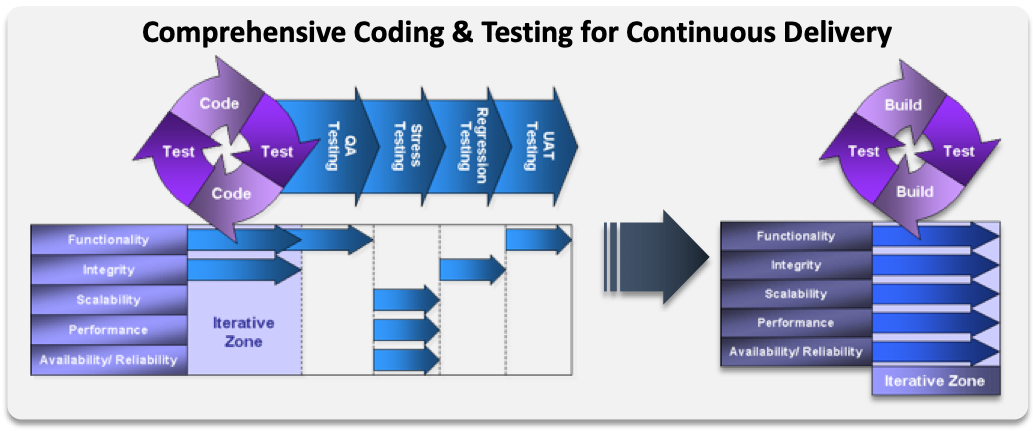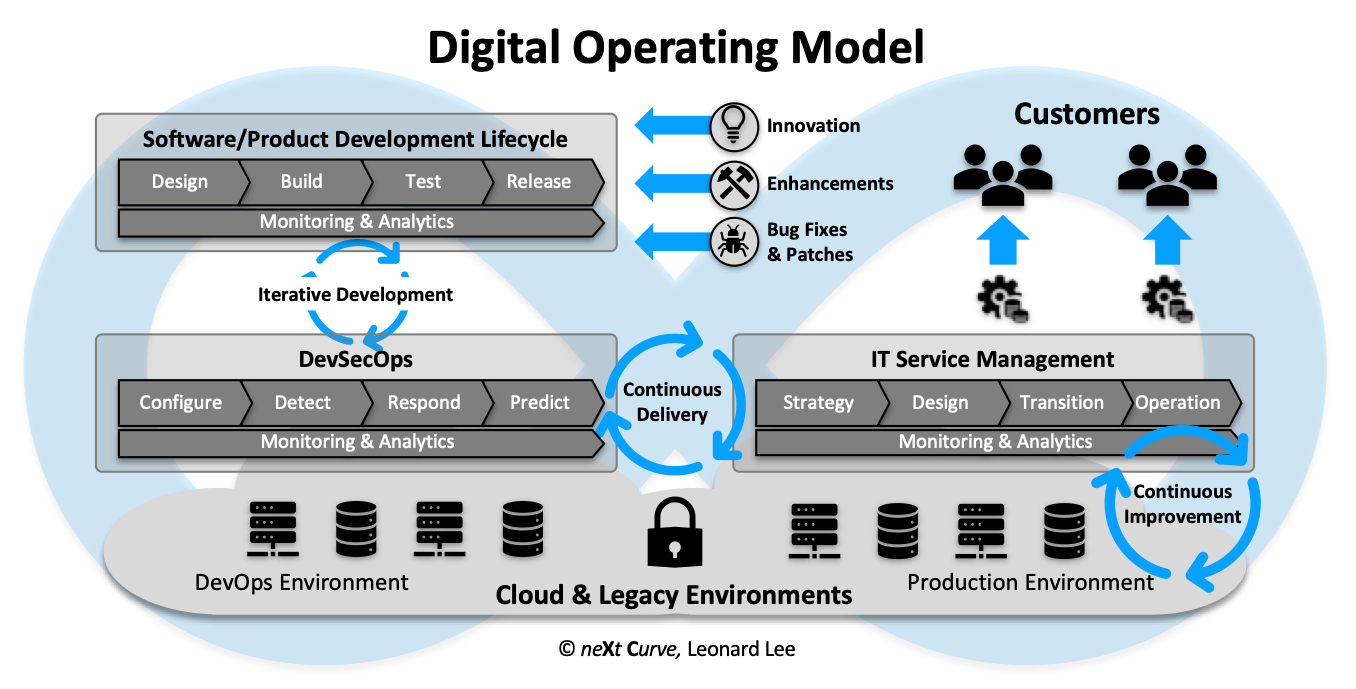There is a lot of noise today about the use of Agile in digital business. In my experience helping early “eBanks” and Dotcoms innovate their web development and Internet operations and advising some of the leading digital enterprises today with their transformation and reinvention initiatives, I have come to realize that there is a fundamental misunderstanding of Agile as it pertains to “digital business”. Furthermore, there is a pervasive misconception that Agile practices somehow translate into business agility and adaptability. Not true.
Just because your organization is committed to becoming a “digital business” does not mean that you should start applying Agile software development, DevOps, ITSM (IT Service Management) principles and practices to the way that you run and manage your business even as it adopts a more digital form and mode. Methodologies are just tools that should be adapted to the particulars of your industry, your business and your organization – especially in consideration of the way your people like to work.

According to a survey study published by Wipro in June of 2017, only 50% of senior executives of companies that participated indicated that their organizations were successfully executing on their digital transformation strategies. Whether you are a business looking to digitize or a service provider looking to provide digital transformation advisory to your client, it is important to bridge the semantic disconnects and the misconceptions that can cause miscommunication, misaligned expectations, and a troubled digital journey for you or your client’s business.
Agile Development Does Not Equal Agile Business
So, what is Agile? For those of you who are new to software development, here is a short, easy-to-swallow definition. Agile is wide range of methods and practices (e.g. SCRUM, Extreme Programing, DSDM, etc.) that share the common methodological traits of iterative cycles of analysis, design, coding and testing to progressively elaborate/define a software-based product through the quick and frequent release of, feature-prioritized, working code (a.k.a. minimal viable product).
Agile methodologies and practices are frequently used to de-risk software development efforts when the “customer” is not clear on the business requirements or expectations and what the outcome of investment is supposed to look and feel like. In short, it is a great method for dealing with ambiguity whether you are trying to develop software or a digital service. Agile methodologies are not intrinsically methods for innovation much less business innovation. Don’t let anyone confuse you in this regard.
DevOps is Great for Digital Platforms, But Apply with Caution in Physical Contexts
If you have been hanging around techie folks, you have probably heard the term “DevOps” floating around in digital conversation. If you haven’t, you will. You will get an earful from your digital business consultant or CIO for sure. In the simplest terms, DevOps is a way of managing non-production (development, testing, QA) IT environments to rapidly deploy configurations, builds and environment instances needed to support the frequent develop-test iterations associated with Agile development approaches. Why DevOps? DevOps can accelerate software development cycles (build, test, release) so that you can get more stuff into production faster – continuous delivery.

DevOps is a really cool concept that came about to address the rapidly increasing velocity of web application development during the Dotcom era. Think of software development activities, whether executed based on Agile or traditional (“waterfall”) software development and project management practices, happening on top of a digital delivery chain and environment that is managed using DevOps practices and principles.
IT Service Management
The third dimension of the IT universe that digital mavericks rush to apply to physical operations is IT service management (a.k.a. ITSM), which is a set of disciplines and framework for managing the ongoing delivery of IT or digital services to users and customers. These digital services can be infrastructure services (network and servers), platform (development platforms, middleware and tools), or software applications (think Oracle or SAP applications), or all of the aforementioned.

For business folks, IT service management is synonymous with your supply chain and business operations. ITSM boils down to how you manage the delivery of value to your customer. IT service management is primarily focused on production environments and the continuous improvement of IT service delivery. It also includes the process of release management and controls for introducing new applications and IT services into production from the software development process.
The Digital Operating Model
All too often the topics of Agile, DevOps or DevSecOps and ITSM are discussed in relative isolation of each other, though in recent years there has been growing interest in how Agile and DevOps can accelerate software development. Incidentally, there is quite a bit of overlap between the three disciplines with some gap areas, in particular, security which is being addressed in the extended DevOps concept of DevSecOps.
But what do Agile, DevOps (DevSecOps) and ITSM look like when you mash them together? They come together in what can be considered a Digital Operating Model.

The important thing to understand is that Agile methods and the principles of the Agile Manifesto do not necessarily garner the business agility suggested by the Digital Operating Model. In fact, DevOps and ITSM do not rely on Agile software development principles or methods to deliver the benefits of continuous delivery and continuous improvement that can be realized through mature implementations of DevSecOps and ITSM practices, processes and governance. On the contrary, waterfall and iterative approaches to software development can benefit from DevSecOps thanks to emerging software platform technologies such as containers (Kubernetes) and serverless computing. The days of procuring dedicated server hardware and software, mounting bare metal in the data center, and installing the OS, database software and the application are pretty much gone thanks to virtualization.
Speaking of virtualization, as a business leader, you need to consider how “virtualized” your products and services are before you pursue the promises of Agile. Recognize that not everything is software and software will not eat everything as Marc Andreessen so famously opined back in 2011. It is important to understand how Agile works and doesn’t work in the context of what it was created for – software development.
Proceed with caution.
Implications for Business and Technology Leaders
Business leaders should be cautious about pursuing the dramatic transition from more traditional models of operating your business to a model inspired by software development and IT service delivery. The key factors to consider are the nature of the digital transformation and the readiness of your organization to adopt IT-based operating principles and practices.
Quite simply, the physical constraints of your digital transformation will make practices such as Agile and DevOps less beneficial than you might expect or need. Consider the risks of pursuing something that is not fit for purpose. Besides, there are many instances when waterfall project methods and traditional operating practices make perfect sense even in a digital context. Consider hybrid methods because it is difficult to find any organization that has fully adopted Agile methods or realized DevOps for their digital business.
Finally, consider the general lack of experienced people with the competencies that you need for your digital ambitions. How many people are experienced in truly innovative digital business models? But more importantly, how ready are your organization, your employees, your suppliers and your ecosystem partners to adopt practices that many IT organizations struggle to adopt and implement fully and successfully?
If you are interested in getting additional insight on the topic of digital reinvention and operational transformation strategies for your enterprise, contact us for an inquiry session with our neXt Curve analysts and consultants.
Related Content & Media
- Digital Reinvention – Part 1 (webinar)
- Digital Reinvention – Part 2 (webinar)
- Digital Reinvention – Part 3 (webinar)
- The Future-Proof Organization
- The Alpha Organization (webinar)
- The Alpha Organization: Preparing to Succeed in a Digital Future
- Want to Get Value Out of IoT? Stop Talking About IoT
by
Leonard Lee
Managing Director, neXt Curve
October 16, 2017
This material may not be copied, reproduced, or modified in whole or in part for any purpose except with express written permission or license from an authorized representative of neXt Curve. In addition to such written permission or license to copy, reproduce, or modify this document in whole or part, an acknowledgement of the authors of the document and all applicable portions of the copyright notice must be clearly referenced.
© 2018 neXt Curve. All rights reserved.
Brilliant description of the concepts in question and pitfalls of associating buzz with always positive outcomes. The very nature of being an excellent consultant is delineating between the hype and the actual implementation. Great article.
We appreciate your comment and we are glad you liked the article. Look forward to your readership and feedback.
Interesting…I always questioned the notion of Bi-Modal IT, having one team perform with the latest and greatest tools, DevOPs, Agile, and usually the more fun applications, etc…and another team saddled with older systems, legacy tools, etc., creating animosity and siloes. What if both teams work together, in a hybrid DevOPs and classic waterfall approach, with newer tools migrating the legacy systems towards DevOPs from vendors like Compuware, and others…and the newer solutions with DevOPs and DevSecOPs… Eventually the siloes are broken down, with better cohesion, and with common solutions/platforms, converged offerings can occur connecting the disparate systems, with a shared set of analytics/metrics, leading to better analysis and recommendations for improvement, better team morale, and hopefully leading to an Agile/Algorithmic Business !